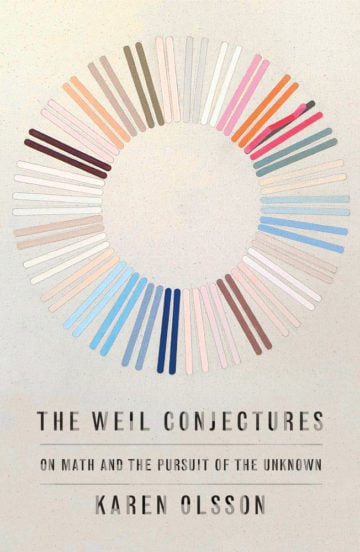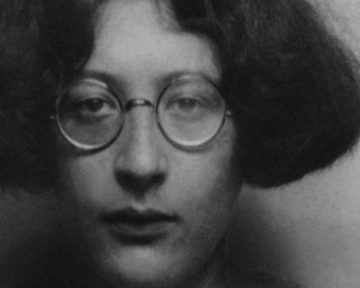The Latin root of the word conjecture, conicere, means to throw things together. Think of Jackson Pollock splashing different paints onto a canvas and hoping for some kind of coherent result. In mathematics, the term refers to a proposition offered without definitive proof. These varied meanings make the word fitting to include in the title of Karen Olsson’s new book, The Weil Conjectures, an experimental, tantalizing hybrid of biography, memoir, and meditation.
This is the third and most ambitious volume from Olsson, a longtime Texas writer and former Texas Observer editor, who also authored Waterloo (2005) and All the Names (2015). The Weil Conjectures is a study of French sibling geniuses André Weil, a 20th-century mathematician famous for his conjectures, and Simone Weil, a philosopher and political activist. Arrested for draft evasion in 1940, André did some of his most intense work in a French prison, and Simone became a mystic before dying at 34 after refusing to eat, possibly as a form of political protest. Their extraordinary lives offer a biographer ample material.

But Olsson is more than a biographer; she weaves her own personal reminiscences and reflections in with the lives of historical figures. In a typical passage, André is using anecdotes from the lives of two great mathematicians, Sophus Lie and David Hilbert, to explain his own research to Simone. Olsson interrupts her account to note that both Lie and Hilbert suffered from pernicious anemia, whereupon she begins discussing the disease’s symptoms and causes. Then she abruptly declares: “But I digress.”
Digression, the organizing principle of this book, is the temptation of the intellectually adventurous and inquisitive, who will binge on Olsson’s bracing prose. She traces her interest in Simone Weil back to her own gawky teenage years, when she found an imaginary friend in “the petite French ascetic with cool hair and wire-frame glasses, the political activist/intellectual/mystic who died young.” Her attraction to Simone’s cantankerous brother is a function of Olsson’s own infatuation with math. Olsson majored in it at Harvard, not because she was one of the geeky prodigies the subject attracts but because she was excited by the challenge of testing her own limits.
After graduation, she abandoned numbers for letters to pursue a successful writing career. “How I would like to write something as clean and powerful as the best kind of mathematical proof,” she sighs, recognizing that, at their highest levels, neither André’s conjectures nor Simone’s speculations nor her own texts can ever be conclusive. All three lose themselves in projects that defy consummation. As Olsson observes about André, “The flicker of a parallel, the suspicion of a connection, excited him, more so than nailing it down, working out the details. As though knowledge itself were a bit of a letdown: it’s being on the cusp that brings the greater thrill.”

What Olsson calls her own “math fever dream” lasts for less than three years. Now decades removed from serious work in math, Olsson begins watching YouTube lectures by her old college professor. Though she recognizes that the subject has become a foreign language to her, she respects Simone’s contention that, “[U]nless one has exercised one’s mind seriously at the gymnastic of mathematics one is incapable of precise thought, which amounts to saying that one is good for nothing.”
The Weils certainly exercised their minds seriously, often exchanging letters in ancient Greek. From prison, André sends Simone a 16-page missive dense with such concepts as quadratic residues, nth roots of unity, extension fields, and elliptic functions. Simone is puzzled by her brother’s epistolary treatise, and she asks him to explain it. However, André, for whom the mind is an engine for generating analogies, has already told her that, “Telling nonspecialists of my research or of any other mathematical research, it seems to me, is like explaining a symphony to a deaf person.” Olsson returns herself to the narrative, admitting that she herself cannot fathom André, that he is a thinker “whose work I don’t understand.” Olsson ultimately positions herself, along with this reader, who never got beyond calculus and analytic geometry, with the deaf person confronting a symphony.
Nevertheless, what she and any reader can envy is the “lucid exaltation” attained by immersion in a discipline such as pure mathematics. It is not necessary to be fluent in Diophantine equations, Hilbert spaces, and Fourier analysis—or even André Weil’s conjectures—in order to read The Weil Conjectures, a book ecstatic with intimations rather than mere equations.
Read more from the Observer:
-
The Flood Next Time: In the floodplain of the Rio Grande, Trump’s wall threatens to inundate communities on both sides of the border.
-
‘Black Light’ is a Weird, Wonderful Fever Dream of a Book: People glow, hunt for psychedelic mushrooms, and fall in and out of love in Kimberly King Parsons’ debut short story collection.
-
Goodbye to the Amarillo Art Mall: After 14 years, the artist colony inside a former Amarillo shopping mall is being laid to rest. Now the Panhandle creative-types who called the place home “are just gonna get scattered.”







